As you can see on this Dripps Atlas plate from 1867 (zoom in for a closer look) , in the ‘beginning’ there were nine streets that ran up the Lower East Side, parallelling the East River all the way to Corlears Hook… South, Front, Water, Cherry, Monroe, Madison, Henry, East Broadway and Division. These streets, as well as their cross streets, Catharine, Market, Pike, Rutgers, Jefferson, Clinton, Montgomery, Gouverneur, Scammel, Jackson, and Corlears, were jam-packed with cold-water tenement houses, all of them filled with families — making the Lower East Sde one of the most densely populated neighborhoods in Manhattan.
Beginning in the 1930s, the grid was interrupted as large “towers-in-a-park” housing projects were built, one by one — the Al Smith, LaGuardia, Rutgers, Vladeck, Knickerbocker, Corlears Hook Houses. Entire blocks were eliminated and, in some cases, entire streets, such as Oak, Front and Scammel, and some streets such as James and Monroe were reduced to a block or two. (It’d be fun to create a Random Name Generator of the neighborhood, since you can get famous names like Henry James or James Monroe. )
One street, though, seems to have preserved much of its old tenement flavor, Henry Street, which along with Rutgers Street was named for Revolutionary-era soldier and wealthy landowner Henry Rutgers. I walked the entire length of the street during a brief time in the winter of 2014 when the temperature edged above freezing and the glaciers retreated.
Henry Street’s entire length has been preserved from Oliver Street northeast to Grand Street at Lewis. The first prominent building to be seen is the Ionic-columned Mariners Temple Baptist Church — a very old church, but not Henry Street’s oldest. The Mariner’s Temple was built in 1845, though the parish, serving a congregation of sailors and maritime workers and their families, goes back to 1785; there has been a church in this location just about since the streets themselves were built just after the British colonial era ended. The cornerstone of the first church on the premises has been preserved and can be seen above the front entrance.
As maritime activity shifter to the deeper waters of the Hudson, the early Church continued its ministry and gained an additional name, “The Mother of Churches.” As Swedish, Italian, Latvian, Russian, and Chinese immigrants moved through the Lower East Side, Mariners’ gave life to the first Swedish, Italian, Russian and Chinese Baptist Churches, as well as the Norwegian-Danish Mission of New York City…
From the middle to the late 1900s, Mariners’ Temple continued to be a spiritual center for all ethnic groups in the neighborhood. In the midst of the Civil Rights Movement of the 1960s, Mariners’ reached beyond the spiritual realm to address the political needs of the community. Locally, there was picketing of low-income housing thought to be urban removal rather than urban renewal. Nationally, Mariners participated in the famous “March for Jobs and Freedom” held in Washington, D.C. in August 1963…
By the early eighties, the congregation was mainly Chinese and African-American, with separate services held for each. Later, the Chinese congregation moved into its own church in the area. In May 1992, the congregation paid off the mortgage on the church building and celebrated the title transfer from the American Baptist Convention/Metro NY to the Mariners’ Temple Baptist Church congregation.
Today, there are two unique congregations at Mariners’: the Sunday morning congregation and the congregation from Lunch Hour of Power (LHOP), which was established in the 1980s under the pastorate of Rev. Dr. Suzan Johnson Cook. The LHOP congregation, which is comprised of government and corporate employees in the surrounding area, worships at noon on Wednesdays. Mariners Temple Baptist Church
Across Henry Street from the temple is another venerable edifice, PS 1, the Alfred E. Smith School, named for the “Happy Warrior” NYS Governor who grew up in the neighborhood as a boy. It was built in 1897 as Grammar School No. 1.
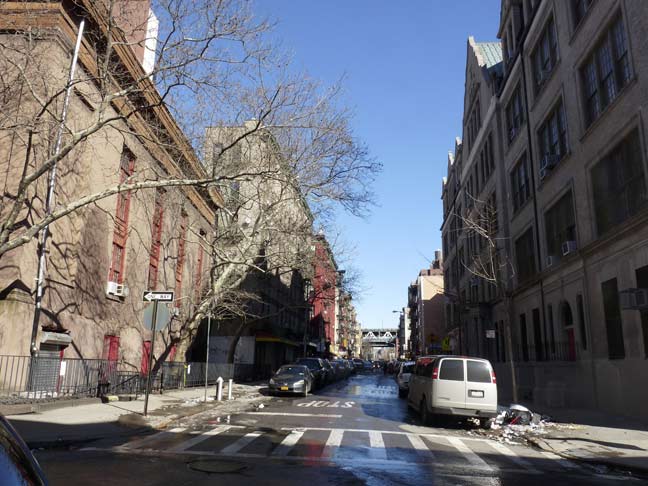
Henry Street looking northeast from Oliver Street
#39, 41 and 43 are an interesting trio of tenement buildings on Henry Street. 39 and 41 are a matched pair, still with their original scrolled iron railings. A bearded paternal head (Zeus?) overlooks the front door, flanked by two female busts. Shouting bearded figures appear below pedestals on the third floor windows.
#43, meanwhile, in brilliant red brick with green cornices and white trim plus the word “Manhattan” at the roofline has cherubic figures on the pilasters at the front entrance. A roaring feline-appearing monster guards the keystone above the entrances, while other roaring creatures appear on both sides of each floor above the first.
At the SW corner of Henry and Market Streets is what was originally the Georgian Market Street Reformed Church, which was built in 1819 — it will celebrate its 200th anniversary soon. The windows are made up of multiple panels –35 over 35 over 35. This is now the First Chinese Presbyterian Church, which shared the building with the Sea and Land Church until 1972.
The brick and stone Georgian-Gothic church at 61 Henry Street was built in 1817-19 as the Market Street (North) Reformed Church on land donated by Colonel Henry Rutgers. In 1864, the Dutch Reformed Church disbanded. The church building was then bought by Hanson K. Corning in 1866 and it was transferred to the Trustees of New York Presbytery to be occupied by the Church of Sea and Land which served the seamen community in the area. In 1951 the First Chinese Presbyterian Church moved to its current location by sharing the building with the Sea and Land Church. The Sea and Land Church was dissolved in June of 1972, and in 1974 the Presbytery transferred the building as a gift to the First Chinese Presbyterian Church. In 1966, the New York City Landmarks Preservation Commission designated both the church building and its Erben pipe organ to be historic landmarks. The church building has the distinction of being the second oldest in New York City. NYC Organ Project

Pike Street is a southern extension of Allen Street (which in turn transfers its traffic to 1st Avenue at East Houston Street. When Allen Street was widened and given a center median in the 1930s, the median was extended south on Pike Street, which becomes Pike Slip near the East River to commemorate its former life as a docking slip for vessels. Pike’s Peak in Colorado, as well as this street, is named for missionary and explorer Zebulon Pike. He was killed in 1813, fighting the British in Canada during the War of 1812.
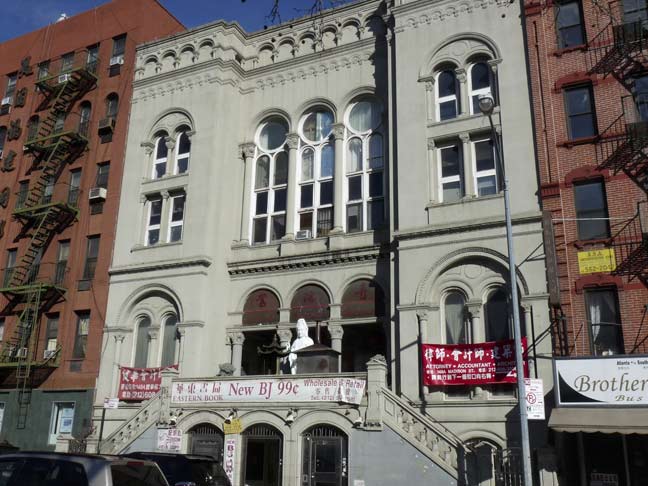
According to NY Songlines, the Sung Tak Buddhist Association at 13 Pike Street was once
the Pike Street Synagogue, a Classic Revival building from 1903 that housed the Congregation Sons of Israel Kalwarie. Eddie Cantor was bar mitzvahed here in 1905.
This is the northeast corner building at Pike and Henry. Once again, a large amount of festoonery, prominent cornice, large window lintels, and a sheltered entrance. A goddess (Cybele, perhaps?) presides over the entrance, but above her on the second floor is a snarling beast. What do these mixed messages mean?
There’s a lot going on at #111 Henry next door. A pair of sullen beasts guard the front door, but their vigilance is tempered by a pair of potted flowers on the pilasters. Two goddesses overlook the second floor windows, while a pair of wriggling fish appear beside the third floor windows. Note how the window treatments are different on every floor. Finally, a green man can be seen just under the cornice on the roofline.
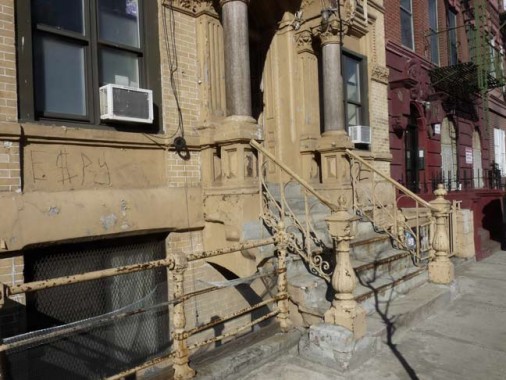
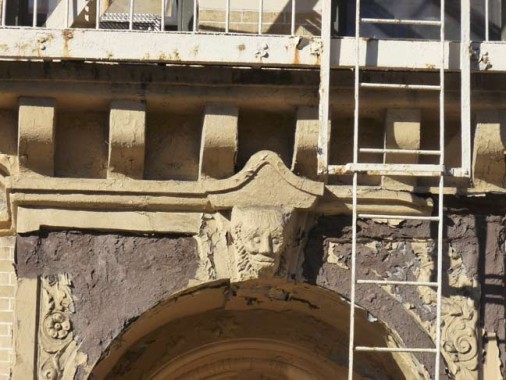
At #117, the front stoop railing and bannister are still in place, though they need paint. Time has worn down the presiding god or goddess above the door to a rather simian appearance.
Why all these human heads and gods above the entrances? My guess is that they are supposed to represent the Roman tradition of lares and penates, household entities who protected hearth and wealth.
At #123 is a real find, a doorway flanked by a pair of mermaid-like caryatids. But they aren’t in the best of shape. One of the lovely mermaids has had an arm broken off, while the other one has completely lost her head. The geezer over the window has weathered badly, as well. The rest of the building looks as if it was subject to a bland makeover awhile back, eliminating whatever other decoration it had.

Henry Street between Pike and Rutgers, looking southwest toward the Manhattan Bridge, Woolworth Building and #1 WTC.

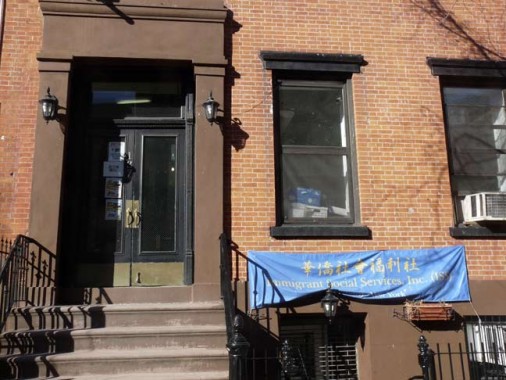
#135 and #137 Henry, modest brick walkups. One is a shul, Congregation Sons of Moses, while the other is home to Immigrant Social Services Inc. Scenes from the movie A Price Above Rubies were filmed at the shul in 1998, while the remains of Shmulka Bernstein, who ran what was at the time the only Chinese kosher restaurant in NYC, are buried within the plot. Henry Bookbinding, noted for custom handcrafted restoration of prayerbooks, is located in the basement of #135.
info from The Synagogues of New York’s Lower East Side, Gerard Wolfe, 2013 Fordham University Press
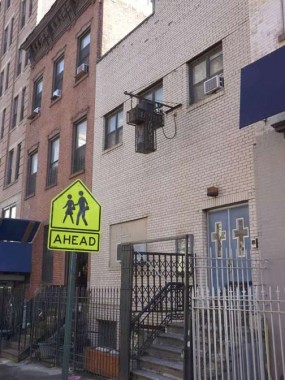
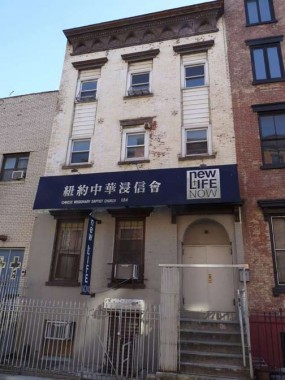
New Life Now Chinese Missionary Baptist Church, #136-138 Henry. I noted the presence of a classic neon cross “Jesus Saves’ sign. I wonder if it lights up at night.
At Rutgers Street we come to yet another very old, but repurposed, church building. The present St. Teresa Roman Catholic Church was built in 1841 as the First Presbyterian Church of New York. It is made of handsome Manhattan schist. The plot where it stands was donated by Henry Rutgers himself. St. Teresa’s parish assumed control very early on, in 1863.
There has been a church at the present site since 1798 when Henry Rutgers deeded out lands for development as New York City continued to expand beyond its old boundary at Wall Street. The church that was established was a Presbyterian church, and after several years of growth, it built the current structure in the early 1840’s. At that time the neighborhood was well established, and moderately prosperous, with the East River docks just a few blocks south. With its new building, Rutgers Presbyterian Church was there to stay.
However in the 1840s the first waves of Irish immigrants began arriving because of the potato famine. They flooded the neighborhood, changing what was a middle class protestant enclave into an Irish Catholic slum. The residents of the Lower East Side began to move, and with it them, the congregation of Rutgers Presbyterian, eventually settling at 73rd and Broadway, where it exists today…
St. Teresa’s had always been a poor parish, worshiping in an old building for which there had never been sufficient funds for proper maintenance. As a result, in 1995 the interior vaulted ceiling of the church collapsed, and 60,000 pounds of plaster fell, breaking through the floor into the basement parish hall. The congregation worshiped for months in a local synagogue, but eventually found the money to repair the floor so that they could worship in the church albeit in the basement. The future looked bleak. There was no money to repair the main church, and many argued that St. Teresa’s should be closed. However, the pastor at the time, Father Dennis Sullivan, and his parishioners were determined that St. Teresa’s would not close. After the school had been condemned and closed in 1942, it had been torn down and eventually become a parking lot, used by the church and neighborhood residents. The late 1990s were a time of rising property values, as New York City began to revitalize and the Lower East Side began to gentrify. Thus through the sale of the parking lot and adjacent air rights, the parish began extensive renovation of the church, including a new roof, new interior appointments salvaged from what was left from the old, and as the crowning glory of the church the restoration of three murals painted in the 1880s, depicting St. Patrick teaching the pagan kings of Ireland, St. Teresa’s teaching her sisters and the crucifixion. The church was reopened in the early winter of 2002 and solemnly rededicated by His Eminence Edward Cardinal Egan in early 2003. St. Teresa
A playground and a school building on Henry between Rutgers and Jefferson Streets are named for Jacob Joseph. In actuality they are named for two Jacob Josephs; the school for the first Jacob Joseph (1840-1902) who served as chief rabbi of New York City’s Association of American Orthodox Hebrew Congregations, a federation of Eastern European Jewish synagogues; and the playground for Captain Jacob Joseph (1920-1942), a great-grandson of the rabbi, who was killed in action in World War II at Guadalcanal.

Behind that red door opposite the Jacob Joseph playground is the rather presumptuously-named World Buddhist Center. Though the Lower East Side was predominately Jewish in the 20th Century, Chinatown has been continuing to spread east, north and west from its epicenter at Canal and Lafayette.

1880s-era undulating brick apartment building at Henry and Jefferson. The bay windows allow apartment dwellers to look up and down Henry Street. Unfortunately the decorative cornice has been torn off on the Henry Street side.

A mythological scene is displayed above the Henry Street entrance. Cupid and Psyche, perhaps.

Street trees appear for the first time on Henry east of Jefferson. In the neighborhood, there’s also a Clinton Street, so lower Manhattan features President William Jefferson Clinton’s full name.
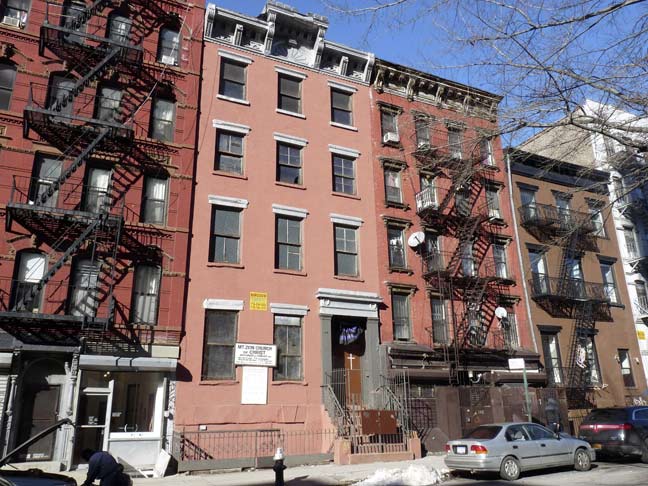
The north side of Henry features an assortment of brick apartment buildings that were handsome in their day.
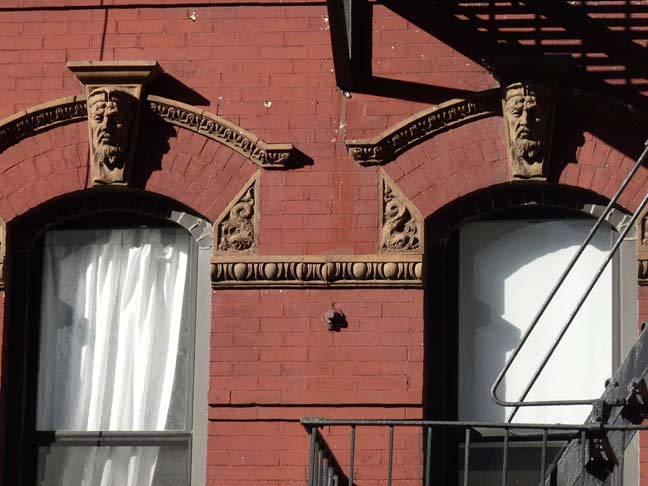
Wise heads prevail at #191 Henry Street.
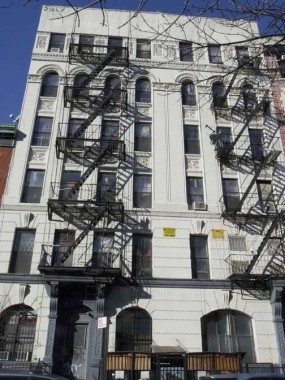

I can’t vouch for the interiors, but here are two more examples from the golden age of tenement building. And the more soot and grime on the outside, the more character it has.
At Montgomery Street/Samuel Dickstein Plaza, you’re in Waldland. From Dickstein Plaza you can see a building with a back porch.
A back porch in New York City? They built houses with back porches in 1827, when 263, 265 and 267 Henry Street first appeared. In 1893 Lillian Wald started the Visiting Nurse Service here with philanthropist Jacob Schiff, an institution that is still going strong today. Wald also started the Henry Street Settlement, an organization bringing a wide range of arts and social services to its community. The Settlement has grown in its over-100 year history to encompass 18 buildings — an it continues to expand. Oddly, both Lillian Wald and Jacob Schiff had NYC thoroughfares named for them, but both have fallen into disuse: Lillian Wald Drive had been East Houston Street between Avenue D and the FDR Drive, while the middle lane of Delancey Street between Bowery and The Williamsburg Bridge had been known as Schiff Parkway.
The Henry street Settlement hopes to convert the former Engine Company 15 firehouse at 269 Henry Street (built in 1883) into a community center. The fire station moved a few blocks away to 25 Pitt Street in 2001. It’s among one of the handsomest firehouses (or former firehouses) in town, with liberal use of terracotta, which appears to be imitating burning flames.
I Dreamed I Saw St. Augustine
The original name of St. Augustine’s Episcopal Chapel at #290 Henry near Jackson Street was All Saints Free Church, which is still carved over the front entrance. It too was made from Manhattan schist, like St. Teresa’s as well as First Chinese Presbyterian Churches (see above). It was completed in 1829. In “free” churches, rent was not charged for pews. In 1949, the congregation merged with St. Augustine’s Chapel of Trinity Church, then located at 107 East Houston Street, and the new combined congregation used the building on Henry Street.The parish became independent of Trinity in 1976.

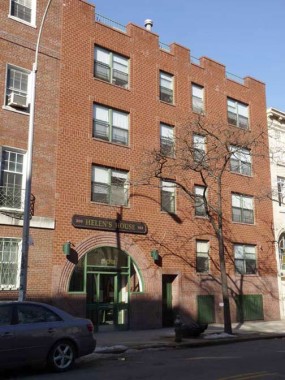
301 Henry Street, of the Henry Street Settlement, consist of “Helen’s House” and “Pete’s House.” Helen’s House opened in 1991:
The building known as Helen’s House is named in honor of Helen Hall, who followed Lillian Wald as Head Worker of Henry Street Settlement in 1933. She directed the Settlement for over 30 years and was an author and activist concentrating on social reform in policies focusing on homelessness and municipal shelters. Today, Helen’s House provides emergency housing for mothers or fathers with children up to the age of seven…
Pete’s House, the earlier of the two structures, originally held a pair of row houses that were altered over the years for multiple housing. By 1920, the two original buildings were functioning as a small synagogue. The Settlement acquired the property, and with extensive alterations converted it into a youth center. The project, funded by Edith and Herbert Lehman, was named Pete’s House in memory of their son Peter, who had worked as a volunteer youth leader at the Settlement. During World War II he was an officer in the U.S. Air Force, and was killed in England in 1944. Henry Street Settlement
Charles and Stella Guttman Building, Henry Street Settlement, completed in 1962. I usually don’t like 1960s architecture — I consider it cold and forbidding — but this building is an exception to that rule.
The four-story with basement structure has white glazed brick, blue and yellow terracotta spandrel panels and limestone columns and copings clad across the upper front facade. The original renderings of the building called for a glass curtain wall between the columns across the first level at the street level. Instead, the architects used blue tiles showing animal and jungle fantasies designed by the children from the Settlement’s art programs. The prominent limestone band above the first level is carved with the benefactor’s names. The interior lobby retains the original multi-color glass one-inch wall tile, which was very popular during the period. The addition upgraded the youth center with an elevator, HVAC system, gymnasium, classrooms, and library that more than doubled the Settlement’s capacity to serve the youth in the community. Henry Street Settlement
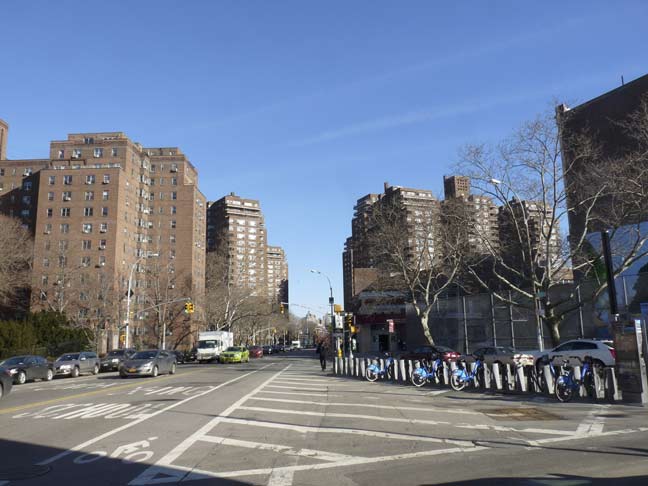
Henry Street ends at Grand Street, the Corlears Hook Houses and a gaggle of CitiBikes.
3/2/14


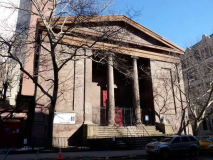
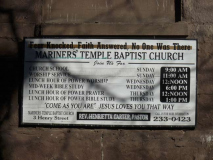
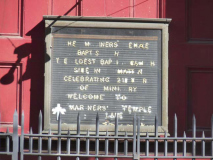

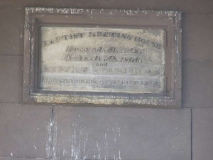
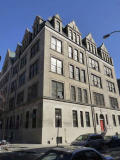
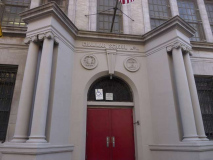
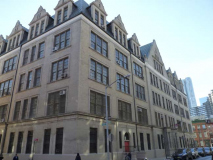
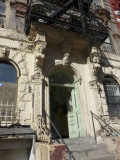
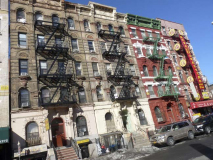
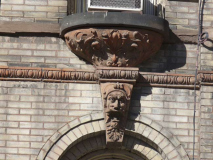
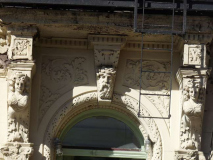
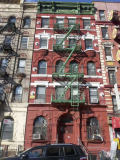
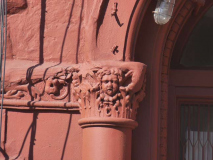
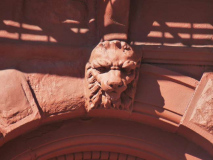
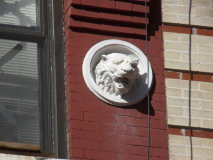
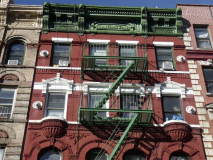
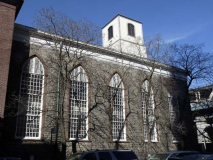
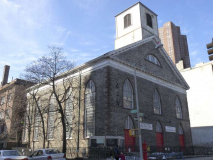
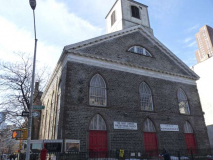
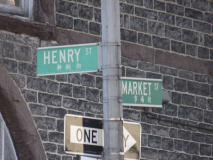
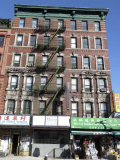
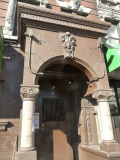
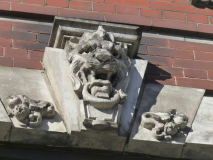
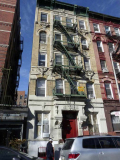
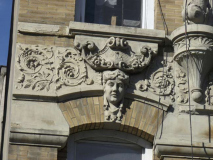
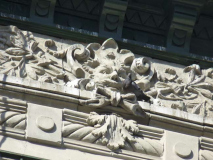
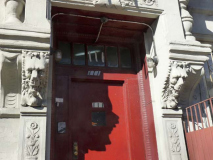
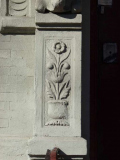
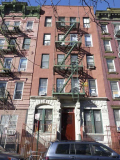
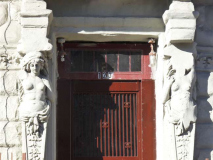
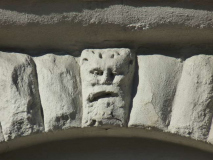
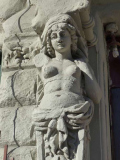
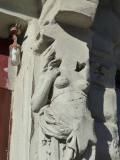
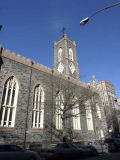
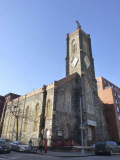
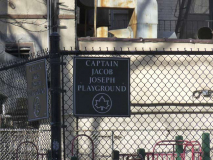
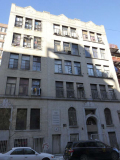

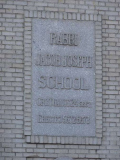
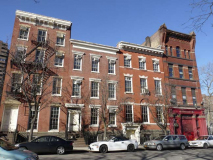
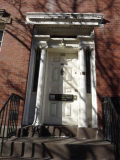
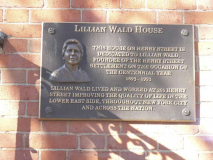
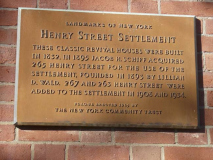
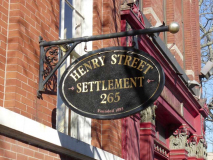
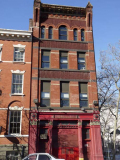
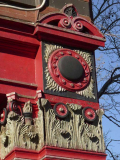
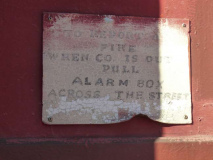
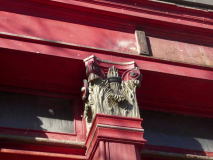
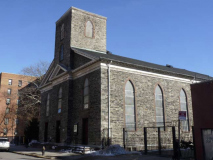
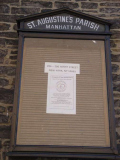
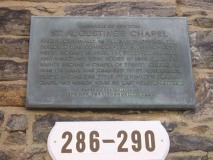

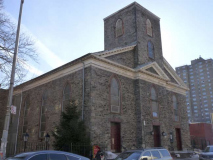
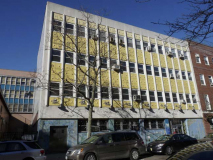
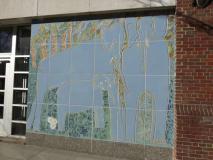

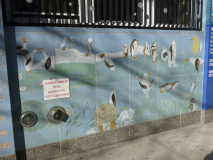
64 comments
Thanks for your tour of Henry St. My great-great grandparents lived at 58 Henry St in the 1880’s and 90’s. my great-great (grand?) uncle went to grade school with Al Smith. I was 14 and my uncle was 99 at the time and he was quite proud of Al. Henry St may not be the prettiest street in the city but it means a lot to me. Thanks!
My father’s first residence when he came to New york was at the Henry Street Settlement. He wwas a young Socialist from North Carolina who wore the ideals of the Henry street Settlement for his entire life. After his death in 2012, at 96, we had his Memorial service and a Rememberance dinner at the Settlement.
The second of four photos of the First Chinese Presbyterian Church in the article shows a white wall to the right of the church building. Underneath the white paint was a large Fletcher’s Castoria ad that was in very good condition, hardly faded. Unfortunately, it was painted over several years ago.
Great read! Where did you get all the great info?
39 – 43 Henry Street looks like the buildings on Led Zeppelin’s Physica Graffiti album.
The buildings on that album cover are actually 96 & 98 St. Marks Place. Lived two doors down from them for a year.
I was born (1924) and raised on the NYC Lower East Side, living at 15 Montgomery Street at the intersection with Henry Street and at 10 Montgomery St. at the intersection with East Broadway. There were many youths of all ages living in the tenement houses that area. In the 30’s there was the NEW ERA Club, modeled after President Roosevelt’s New Era theme. In the late 40’s, retuning veterens organized a cellar social club located on East Broadway and Grand St called The HenMonts, named after Henry and Montgomery Streets where they played and socialized in their youth. I descibed life in this area very extensively in my autobiography, From NYC Lower East to NASA Satellite Operations Manager. It covers all aspects of living, at all ages. This book can be read or purchased on the Internet. Will gladly adress questions pertaing to the Lower East Side of my time period (1924-1950).
ha i may check out your book! you should check out ‘when i was last on cherry street,’ a great autobiography by harry roskolenko about growing up in the lower east side. strangely, my copy’s dustjacket by was designed by an old world writer whose creative writing class i took as a small child growing up in the bronx.
Hi Ralph: On the corner of Henry and Montgomery there was a soda fountain parlor and I think it’s name was “Shapiro’s” (of all names!). Do you recall this? Also, down Montgomery on Madison St. was a Jewish deli, Meltzer’s, owned by 4 or 5 brothers. Do you remember it? I could go on and on reminiscing about Henry St. and the lower east side, and I do occasionally visit there – just for the memories. I wish there was some way we could talk ab out the old days directly. Do you think this site would give you my email address (email – like science fiction from the old days, eh!)?
I remember meltzers! The deli we always ate at. One of the brothers was named “lippy” Iremember when corned beef and pastrami on club went up to 35cents! My father knew all the brothers I believe one was named “bulldog”. I have searched high and low for sandwiches like that and have finally found it in las vegas. Canter’s Deli which is a California chain. I was brought up on the lower east side, Do you remember Marchioneys?
That candy parlor was my fathe’r,s. He had a candy stand there for twenty years ear,pier. I lived there until 1940.
Will be glad to chat, show pictures.
Ralph
Hi
I was born in 1940. Please write,
John
Does anyone have any pictures or information about muskin’s restaurant on east Broadway
Hi:
Thanks for the memories. We moved to 226 Henry from Rutgers Place in 1945.
I went to the Edgies, Seward Park,and the library on East Broadway was my favoprite place. I went to the Henry Street Settlement kindergarden, PS 147 and I use to go to the church on Henry near the Settlemtnent. I learned phjotography at the settlement when I was around 1953 and in 1969 I joined the NYTimes as a staff news photographer..
Jopse Feliciano used to live on Henry between Clinton and Jefferson. I met him in 1952, I was 12 and he was 8. . He played a conertina and I played the guitar I was a member of Club 16 and we use to hjold dances at the Settlement.
I can still remeber exactly how my kindergarden class looked like. I just published a book ofn the string folk instruments of Puerto Rico where my parents were born. I would enjoy hearing from anyone from Henry Street..
Dear Mr. Sotomayor,
I grew up on Avenue C…mostly ..but I was a teacher on Montgomery and I lived in the coop. My mother told me the Jose Feliciano was my aunts neighbor .in the early years…..I never knew which street……
I would like to look into your book….I have been interested in learning to play the cuatro…..What is the title of your book?
Warm regards,
Cynthia Bielicki Padilla
Hello
Please write.
John
Hi
I knew Jose neighbors. Please write,
John
Hi, John. My grandparents lived at 226 Henry St. until 1958. Do you remember the tailor in one of the basement retail spaces – I think his name was Palutsky – and the plumber on the other side – I think it was Elkay plumbing? We called the janitor “Spaks”, and the landlord was named Morgenroth.There was also a family doctor across the street – Dr. Goldberg – back in the day when doctors made house calls. At Montgomery St and Henry there was a soda fountain parlor – I think it was Shapiro’s, but I’m not sure. Do you recall it? In the other direction at Clinton and Henry was Sussman’s bakery and Benny’s candy stand on Clinton, and across the street on the even side of Henry was Jack Ripp, Michael’s barber shop was near that corner, to, as was Tailor (very appropriate name, eh). There was a synagogue right next to 226, and a men’s club in the basement. I could go on and on. I wonder if there’s any way to get in touch so we can share some memories (we seem to have many in common!). I also went to the Edgies, the Henry St. Settlement, and Seward Park Library. Of course, 226, and the whole side of Henry between Clinton and Montgomery was torn down in the early ’60’s for that school complex. But I still try to visit there occasionally.
Hi
YES, I rememberevr all. I must have known them.
John
Hi I lived at 83 Henry St, moved to the Bronx 1956 I’m looking for friends I lived on Henry St for some years from the forty’s to late 50’s I went to P.S 177or ,77 on Monroe and also Charles Sumner JHS
Fred Kaufman
My paternal grandmother was Anna Cooper (Kaufman) born Mary Cooper and she was born at 77 Henry St in 1894. She had a brother named Arthur Cooper and her parents were Baruch and Etta Cooper. Both were born in Russia. Did you know them at all Doris Faura?
My father was born in this building April 1912 and also moved to the Bronx. I think the building was built in 1920 . Would love to see picture of the original building.
i’m not from Henry street but I lived in Vladeck Houses and that’s where I was brought up. I started P>S> 31 on Water street (where I lived at.) I also went to the Henry St settlement and took piano lessons there, I frequented the Edgies and the Seward Park library was my favorite place. After first grade in p.s.31 I was switched to P.S. 147 and went to Corlears Jr H>S>
My husband, who is deceased, lived on 10 Montgomery street. There was Meltzers deli, the Pageant Chinese Restaurant on Delancey, Gluckstern’s, Pollacks, Muskins restaurant on East Broadway, Shorty’s candy store across from. p.s.147. Jackson Park on Jackson street. A restaurant called the Paramount on delancey street, of course Ratner’s and Woolworth’s. We used to take the Green Bus Line to 14th street to the Paramount theater where I saw Frank Sinatra and Patti Page on stage with the movie. Coney Island was to die for! The movies most frequently attended were the Delancey and the Apollo, every week. I could go on and on. Let’s not forget the canal theater and the Garden Cafeteria and Ratner’s.
Hi
I remeember the same. Please write.
John
Thanks for the walk down memory lane. I, too, went to the Edgies (so many fond memories), PS 147- from Kindergarten with Mrs. Goodman through Sixth grade with Miss Soifer. Henry Street Music School, where I learned to play the accordion, the Seward Park Library where I developed a love of reading, JHS 22 on Columbia Street, and Seward Park High School. Such an interesting place to grow up.
i lived at 238 HenrySt early 50’s thanks for the nice memories…Robert
Hi
I lived ar 226 Henry Sr.
Please write.
John
Hi
I remember the same and more. Please write.
John
Thank you for the beautiful photographs and well researched history. I lived in the neighborhood there from 1968 through 2015. I’ve walked past those buildings so many times. I remember the Pink Shul on Pike that is now a discount store. Or was it the pink shul on corner of Madison and Montgomery that was torn down for a parking lot. I’m away from the neighborhood for awhile and it is like magic to be able to walk the familiar streets and learn more of its history through your excellent website. I will share this with my neighbor who became my sister. She lived on Henry & I on East Broadway; the backs of our buildings touching. We have raised our children together and remained sisters ever since 1973. My kids grew up here & will love these too.
Would like information on any photos of Children’s Art class (Henry Street Settlement. My mother worked at Henry Street Settlement during the 1960’s (Anna Poplis-Mangine). I attended the art class and a picture was taken of me making a clown out of clay. My name is also on the Charles and stella Guttman building (Charles Mangine)
You can learn more about the lower east side cultural and social behavior centered around Henry and Montgomery streets during the 1920-1950 time period by reading my book From NYC Lower East Side to NASA Spacecraft Operations Manager. Learn about the street sports played, (box ball, punch ball, stoop ball, roller skating), hiding games (ring a levio, kick the can and hide), election night celebrations (street bon fires), professional sport enthusiasm (Yankees and Giants baseball and football), depression era activity (bread lines, street dancing, group roller skating, bootleg whiskey, ice man) and much more.
Be glad to hear from former area residents.
Ralph Shapiro
Ralph Shapiro
Hi
I saw the numbers on his arm. Glad he made it. I lived at 226.
John
My Dad took group trumpet lessons at the Henry Street Settlement School when he was in Jr High. He later studied with Max Schlossberg, and at Juilliard with his near contemporary William Vacchiano, before joining the Chicago Symphony in 1941.
Have you ever profiled what remains of Rutgers Street? #24 Rutgers is an antebellum building (at least a building of similar shape & size appears in the 1852-54 Dripps atlas on NYPL, and the window treatments look antebellum as well) where my mother’s father grew up. They later moved to Harlem.
Can someone tell me what was at 205 Henry Street in 1932? My in-laws were married there.
I lived at 218 Henry st in 1944 to 1959 and yes there was.
Did you know the Bavonese family that lived at 218 Henry St.? Carrie Bavonese was my childhood sweetheart. We remained friends since I returned from Vietnam until she passed away couple of years ago. I left the neighborhood when I enlisted in the Army November 1959.
Hi
I lived at 226 from 1945 to 1958.
Wrire.
John
It was a small walk up synagogue in an apartment building.
quick question:
on the henry street side of the Georgian Market Street Reformed Church, you may see a doorway with ‘McAlister House’ in the stone over the doorway (you may view it and zoom in from this internet address on google street maps:
https://www.google.com/maps/@40.7129953,-73.9948962,3a,35.8y,362.33h,91.96t/data=!3m6!1e1!3m4!1svKEsTGK6x556mqTjw1NXgA!2e0!7i13312!8i6656!6m1!1e1.
a while back i googled this name but came up with nothing. does anyone have any clue as to what this was? i’m guessing that that whole building portion of the church was a later edition.
thanks!
My great great grandfather–a sailor from Norway, eventually settled in NYC in about 1855 to become a shipbuilder, and lived first on 217 Madison (between Clinton and Jefferson) and then on 47 Henry St–which unfortunately is now a parking/empty lot. I’m always looking for information about this neighborhood from the mid to later 1800s. One of my Gr Gr Grandfather Thompson’s (spelling of name was anglicized upon his arrival) children died of cholera on Henry St in the mid 1800s and several children died there before the age of five. I so appreciate you sharing your research and photographs, and am a big fan of your site! Also loved reading what others have written here…fascinating to read through the posts above!
I just want to share a few thoughts, its nice to revisit the lower east side and its great history, to all my childhood friends who lived on Madison street, henry street, cheery street, pike street, water street, and all the others places. I will share some names, that were not mention, schools like JHS 12 than change over to JHS 56 now its has a different name but the logo remains on the wall its a good thing!
PS 2 and PS 134 both located on henry street in two locations. the best thing about the lower east side at least from my point of view was all the different kinds of culture living there, now its mostly Chinese and I say that with a great deal of RESPECTS, yes how the times have change! And my finals words a quick shout out to …Louie.. (blackie).Willie…Ralph…Edwin…Eddie…(old ed ) James …Kevin…and the others hundreds of friends I have known to the others who have passed way (RIP).
What up do you no the winds family from the valacek
Hi
I lived on Henry. Write.
John
Love seeing the comments about my dad’s store-Meltzer Bros. Deli, owned by three brothers; my dad was Lippy. No other deli has compared since! So glad others have fond memories as do I and my sister, Linda, and brother David.
Hello
I’m a cousin of yours , my grandfather was Willy and my father was Robert
Meltzer Bros. deli, a dynasty. Madison & Montgomery St. Lippi was my dad.
Hello
I’m the grandson of your uncle Willy Meltzer
I remember when they all locked me in the basement cooler as a joke
Hi
Had first pastrami on club bread. 75 cents. Around 1952,
John
My family of 9 lived on the LES in the late 50’s – late 70’s. We where members of the Sea and Land Presbyterian Church. I have very fond memories.
My grandparents immigrated from Greece back in the early 1920’s. The lived on Henry Street, last name Moraites, Michael, Christine, and they had a daughter Catherine. My grandmother was a cook, and cleaned for people. My grandfather was a painter until he became ill and could no longer work. My mom, Catherine went to PS 1 Anyone recall any Greeks in that area back in the early days, one day I will get back to Henry Street.
I’m in my early 70s and just discovered through Ancestry that my grandfather was Jewish. His parents, my great grandparents, Louis and Anna Lehrman lived at 41 Henry Street from 1890 to 1896. They were from Latvia. This site is giving me a wonderful idea about the lives they lived while in this neighborhood! Many thanks!
Thank you for a great article with wonderful, detailed photographs. I taught 1st grade at P.S. 1 1967-1968. It was a wonderful experience. I recently reconnected with two students I taught back then. I personally grew up in Stuyvesant Town (1948-1968), attending P.S. 19 (the original one on 14th St), J.H.S. 104, Seward Park H.S. (Class of 1961), Queens College (BA 1966) and NYU (MA 1967). I left the USA in 1968, moved to Israel, married an Israeli and now have 5 children (one in heaven) and 11 grandchildren. I was an English professor and just retired. I am now 75 years old.
I just learned today that my maternal great great grandfather Abraham Kriegel, who was a furrier from Minsk, Belarus, lived at 226 Henry St. in 1904, when he petitioned for citizenship. It’s wonderful to read the comments and see others mention the same address. Does anyone have photos of 226 Henry St.?
Hi
I lived at 226 Henry, 5 floor, 1945 to 1958. Please write.
John
Christine Gruters: My Greek grandfather had a coffee shop on Henry Street ( no. 42 I was told.) in the 1910’s and 20’s. Supposedly this was where painters , many who could not speak English yet were hired. My mother told me she lived on Madison St. and went to PS 1. Many were from the island of Icaria . I have cousins named Moratis.
I enjoyed your tour of Henry Street, and can offer some additional info for 173-177 Henry Street, at the corner of Jefferson Street – the large building that is missing part of its cornice. It is called Henry Court, and is an apartment house, not a tenement. It has five large apartments to the floor, and an elevator, built in 1900-1901, the last year of the old building law. After ten and twelve story apartment houses were build in the 1880s, the law was changed so you could only build seven stories, but somehow they built eight!
If you visit the Skyscraper Museum website, look for the youtube lecture by Dr. Zachary J. Violette about his book “The Decorated Tenement.” I think you will find his talk very interesting, and he shows the elevation and floor plan of Henry Court during his lecture.
do you remember the tortorella s jimmy phil and peter they all went to ps 147 lower east side
This page is like a dream come true. When I was a toddler, my family moved to the Vladeck houses, first to the other side of Madison Street and, probably needing more room because of the arrival of my sister, to the Henry Street side, 351 Madison Street, to name names. My memories of P.S. 147: 1st and 2nd grade teachers were Miss Spokoini and Miss Frankel, not sure which is the correct order, not sure of the spelling. Fourth grade: Miss Fitzpatrick.* I also recall a Mr Fuss (vice principal?); was my 6th grade teacher Mr Bloom? We played stickball on the roof. The name Miss Soifer rings a bell, and that wonderful red-brick school, with the elegant main stairwell, was named after Hearn – William Hearn? Just opposite the school on the no-longer extant Scamell Street was a candy store. Also familiiar, Meltzer’s deli, but only the name. The Henry St Settlement was, and still is, a gift from the Lord. *When we did math problems in fourth grade, a few girls walked around and checked our work. Well, one day I did my calculations quickly, got up and started checking the work of my fellow scholars – only to be hauled before Miss F, who explained that her special math-marking monitors did not appear randomly but were selected: by her. I did not get into too much trouble. Anyone else remember the movie The Rocky Graziano story being filmed on Henry Street? From P.S.147, then Corlears Jr High School 12, then Stuyvesant H.S. Have subsequently moved 3,000 miles east.
I had Ms. Spakoni 1945.
John
I’m Thinking that Schmulka Bernsteins Deli wasn’t so bad either??
Hi, Bill Pavlovsky here. I was born at 111 Henry St in 1948 on the first floor apt left side with the large window and later moved to 119 Henry St, that had a real bath room not a scarry hall one with a pull chain that worked fine if not frozen. Life was good, brown water and rats and roaches for my pets, not to mention fast amounts of pigeon poop under our beloved Manhattan bridge. I was there when the new school was built across the street and loved playing in the rubble. Thinking back of a almost third world existence and being now 2022 i am proud to have experienced what most have not. Moved to the Bronx at age 12, went to Nam 1968 and here I am in Northern California with a Henry St soul, Billy
I grew up in the Settlement in the 70s My dad was Donald Parker and my godfather was Atkins Preston. I have many happy memories of coming to work w/ my dad when I didnn’t have school. I’d help out in the day care center, and make cool stuff in the art room. I loved coming to the staff parties that were in the 2nd floor day care classroom w/ attached play yard, and the annual Festival w/ food and rides! And I saw plays at the Henry Street Playhouse too! So many fond memories of that cool building w/ the animals on it!
I lived in 222 Henry st..it’s now a school..lived there in the 60s..just like west side story picture..loved the area nothing but good memories..almost went to the Edgies but decided on Chelsea vhs..from the Cardona family..the Velazquez neighbors of mine..went to Chorlears jh..Henry st.settlement..camp Henry upstate ny..
I am located in Aberdeen , Scotland , just clearing up paperwork of a recently deceased Aunt.
She was well travelled and I just found a menue belonging To the Hole in the Wall Restaurant , 159 Pierrepont Street , Brooklyn NY.
Now written on the reverse of the menue is “Dunlop , Long IIsland College Hospital , Henry Street , Room 220??
By the way the prices on the menue look tempting!! Johnny Walker Red Label Scotch was “40”, a Bottle of Claret was “30” and food Sirloin Steak at 1.75!! Happy New Year to you all across the Atlantic!!